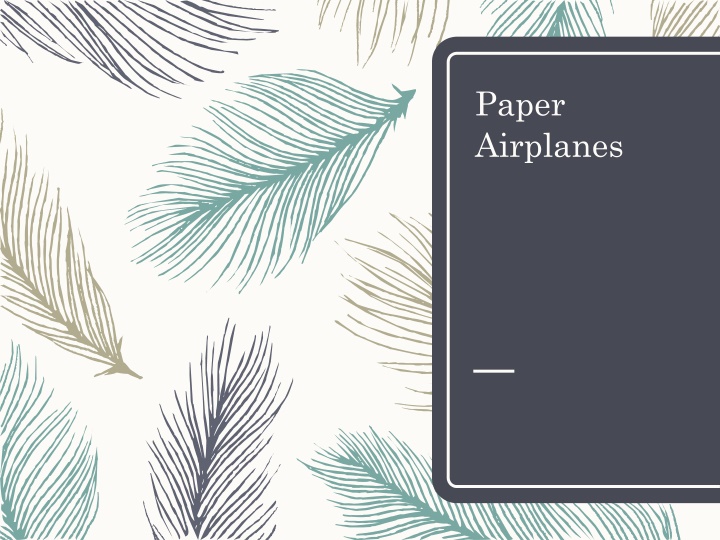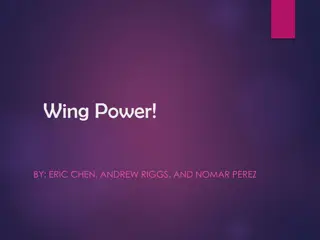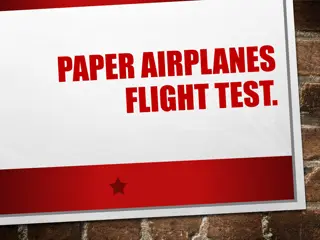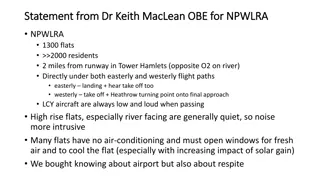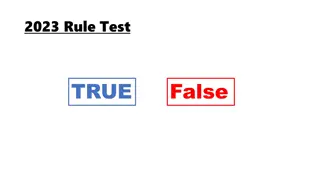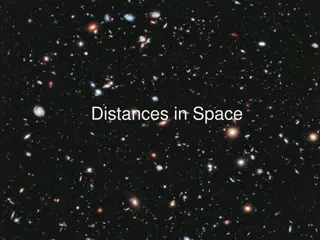Investigating the Influence of Wing Design on Paper Airplane Flight Distances
Exploring how the design of paper airplane wings affects the distance they can fly by analyzing forces such as thrust, lift, drag, and gravity. The study includes data from different paper airplane designs and their flight distances, leading to insights on how wing size impacts flight performance.
Download Presentation

Please find below an Image/Link to download the presentation.
The content on the website is provided AS IS for your information and personal use only. It may not be sold, licensed, or shared on other websites without obtaining consent from the author.If you encounter any issues during the download, it is possible that the publisher has removed the file from their server.
You are allowed to download the files provided on this website for personal or commercial use, subject to the condition that they are used lawfully. All files are the property of their respective owners.
The content on the website is provided AS IS for your information and personal use only. It may not be sold, licensed, or shared on other websites without obtaining consent from the author.
E N D
Presentation Transcript
Paper Airplanes
Question How does the design of the paper airplane wings influence how far it can fly?
Background Research There are many forces that act upon an airplane. Those forces are called thrust ,lift ,drag and gravity. Thrust is the force that makes the plane move forward. Drag is the force that causes resistance to thrust. The airplane needs more thrust than drag so the airplane can move forward. Lift is another force that causes air to go below the wings pushing harder than the air. Lastly, gravity is the force that pulls the airplane to earth. Paper airplanes have the same forces as real airplanes.
Resources Alex Deahr -Guest Speaker Bill Nye The Science Guy Video-Flight http://www.youtube.com/watch?v=FOm1vCx5EHE Brainpop-flight https://www.brainpop.com/technology/transportation/flight/rticl e-How Read Works Do Airplanes Fly
Hypothesis If the size of the wings effects how far the paper airplane will fly, then big wings will fly farther.
Procedures Find the 3 airplane designs you would like to use. Make your chosen paper airplane design. Pick one person to throw the airplane. Throw the first airplane, measure the distance it fly s with a yard sick (record data). Repeat step four three times for each airplane.
Data Paper Airplane Distance Flown Data trial 1 trial 2 9 1/2yrd 6 3/4yrd 2 1/4yrd trial 3 12 3/4yrd 4yrd 2yrd airplane 1 2 1/4yrd airplane 2 6 3/4yrd airplane 3 3 3/4yrd
Graph Airplane Distance Flown (Yards) 12 10 Distance (Yards) 8 6 4 2 0 airplane 1 airplane 2 airplane 3 Paper Airplane Flights trial 1 trial 2 trial 3 average
Results & Interpretation Paper airplanes with different designs flew different distances. Airplane A flew 2 yards the first trial, 9 yards the second trial and 12 yards the third trial. Airplane B flew 6 yards the first trial it flew. The second trial the airplane flew was the same as the first result. The third trial the airplane flew was 4 yards. Lastly, airplane C flew 3 yards it s first trial. The second trial result was 2 yards. The final trial the airplane flew was 2 yards as the result.
Conclusion My hypothesis was, Does the design of the paper airplane wings influence how far it can fly. The experiment did support the hypothesis because there are different designs and sizes. Airplane A average flight was 11 yard. Airplane B flew 8 yards average. Finally airplane C flew the distance of 4 yards. Airplane A flew the farthest because it had more lift than weight. Airplane B was the second farthest because it did not have enough lift so it dived to the floor. Airplane C only flew 4 yards because it had more weight than lift so it could not go as far as airplane a.
